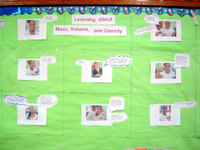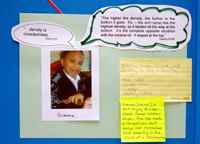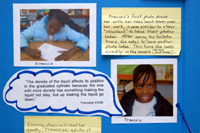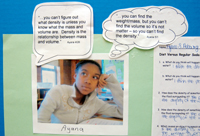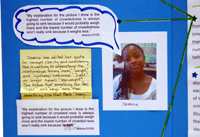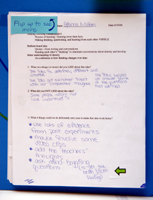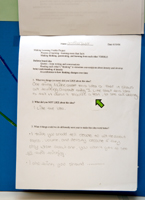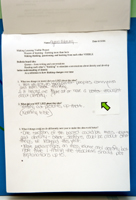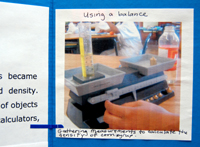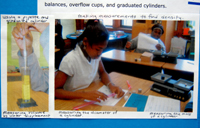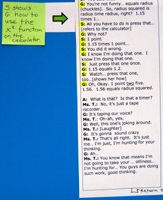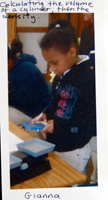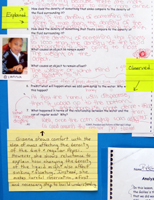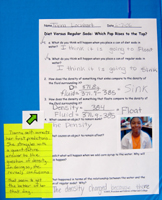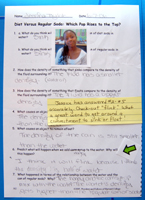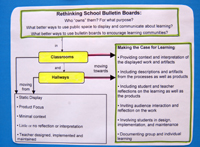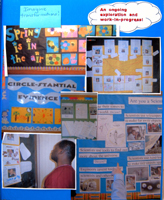A former 5th grade student of mine, in response to his own perceived ?not knowing?, let me know: ?Once is not enough. I need three times at least!? His lament reminded me of how I needed exposure to a new idea and the words to explain it multiple times before I could grasp and remember it. Each encounter helped me clarify, understand, and remember the concept better.
Documentation Examples > Documentation Exhibition
Once is not enough: What effects can making thinking visible have on student learning?
School: Benjamin Banneker Charter School, Cambridge, MA
1. Background:
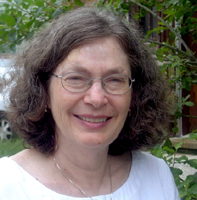
2. Surprises
Jessica liked the bulletin board idea because ?it doesn't require a test to see our thinking.?
The thoughtfulness of the student ideas on how to improve the bulletin board idea surprised me. They included:
? Have more topics on the bulletin board.
? Have teachers write explanations, too!
? Let the students see the photos before you put them up and have one chance to change the picture.
? Let students write questions, ideas, and more complete explanations (make the print bigger, too).
? Post things the class wants to know like a KWL chart.
? Ask a question for each week and have people answer it in the quote ?bubbles?. [?Ask mind-boggling questions?(to get the brain juices flowing.)?]
? Use evidence from past experiments.
3. More Surprises
Gianna and her partner worked together, discussing their measurements.
G: Oh no, that?s acrylic. I wonder if that?s the stuff they use on your nails. [Sounds of using a balance to find the mass.]
S: Put it on five, put it on five. ?Cm?on, cm?on. Ye-e-s!
G: You?re lucky?
G: So you think it?s going to float?
S: Uh?
G: You think it?s going to float?
S: That?s ____. No.
G: Let me see.
S: No
G: This is so light, though [sound of dropping cylinder]. This and wood are so light?
G: I think the acrylic one is going to float, too. All right, well, we?ll see, ? all right, so now we have to go through the volume again.
G: So?
S: [Sighs]
G: O.K. Let?s find the, let?s find diameter. And I?ll find the ?. No ?
S: 2.5 [then too soft to hear and pause]
G: La, la, la, I got 8. [Laughter] Yeah, you taking the bus? I got 2.5, too. All right, so 2.5, 2.5 is the diameter. 2.5 equals d. So now we have to do? All right, I want to see something real quick. Un oh, the wood was 2.3 for the diameter.
S: Wood ? 2.3.
G: All right, so this was 2.5. Hold on, I just have to?divided by?oh yeah. All right, so 2.5 divided by two?1.25.
S: Nooo, it?s 1.25.
G: That?s what I just said.
S: You said 1.25
G: You?re not funny? equals radius [chuckles]. So, radius squared is radius time radius, right? 1.15 times 1?
S: All you have to do is press that? [refers to the calculator]
G: Why not?
S: 1 point
G: 1.15 times 1 point?
S: You did it wrong.
G: I know I?m doing that one. I know I?m doing that one.
S: Just press that one once.
G: 1.15 equals 1.2.
S: Watch? press that one, too?[shows her how]
G: Oh, Okay. 1 point two five. 1.56. 1.56 equals radius squared.
Ms. T.: Do you need one like that?
J: No?
G: I know. Everyone is missing stuff.
J: I was asking something.
G: You can look at it, I don?t care.
G: All right, so?
J: Uhm, when you, when find the, umh
S: We, uh, one, uh got 2.5
J: When you figure out the... uhm
G: Are you talking to me?
S: The volume...
J: No, I wasn?t...
S: The volume...
J: Yeah, when you find it and then find that, what do you do? Do you multiply it?
S: With the height, with the height? What tcha do? What tcha do?
J: With the width and height? Do you multiply it?
S: Ooo?
J: Gianna,
G: Unh?
J: When you find the width and the height, do you, uhm, do you multiply it?
G: The width and the height?
S: ? same
G: That what she says. I don?t know.
J: To get the volume do you multiply?
G: We didn?t do that. She gave us this whole other thing.
J: What tcha do?
G: I don?t know. We had to do like, we had to convert into pi and all that stuff. Uh, I don?t even get a chance to show?
J: Did you figure out the volume?
G and S: Yeah
G: Like she made us change it up. A different way. I don?t know why.
Ms. T.: It?s the area of the base times the height.
S: Yes?
A: The area of the base times the height.
Ms. T.: Not just the width, the diameter, but the area. There?s that the formula.
J: Uh? She knows because that?s what you did.
G: I don?t know. I forgot. I don?t know it. Jessica, Can I see that thing real quick? I don?t know how I did it.
Students return to measuring and calculating for a minute or so before classroom teacher reviews the method for calculating volume.
Afterwards students continue with their work.
4. Reflections About Critique
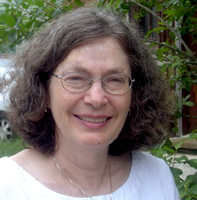
I didn?t take into account the angst of pre-adolescence! Next time I will give the students a choice to post a picture and/or their names. I will also let them revisit their choice and change their picture one time.
Students in 6th grade still love visual and tactile projects and they learn as they work on them. The students and I would set some ground rules and expectations for ?thinkwork? display on a bulletin board. They would have a greater role in selecting quotes and doing more of the work and design to present their developing ideas, and I would post my thinking on the bulletin board as well.
Next steps
I would expand the options for students and me to show our thinking to include:
? review of written work and self-selection of quotes
? using quotes from conversations as well written work
? adding drawings and fuller explanations
? using post-its to comment to one another
I would also model ?post-it dialogue? by writing comments on post-its to the students more frequently. I would refer to ideas on the bulletin board to show that I value the ongoing thinking and build upon it.
I would like to capitalize on students? interest in learning from each other and from me by using more visual reminders, models and a timeline of learning experiences. Students look to learn (and learn to look). This experience has given me extra incentive to post the questions we want to explore (our understanding goals!), the additional questions we want to pursue, and critical visuals to help us remember and build upon our learning experiences.
5. New Possibilities for Bulletin Boards
Can you imagine bulletin boards designed to:
? Communicate and educate the whole community about the ongoing learning in their classrooms?
? Show developing connections among ideas and among people?
? Tell and picture the ongoing stories of groups learning together?
? Invite the viewers to respond to ideas and interpretations?
Can you imagine bulletin boards as:
? Ongoing collaborations between students and teachers?
? Meeting places for curiosity and social interactions?
? Places to foreground what?s important about learning?

